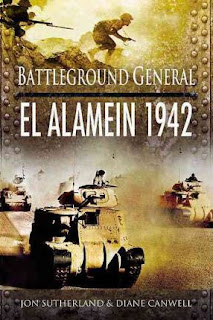War in the Desert: The 8th Army at El Alamein by James Lucas is another one of those books that I think should be 'required reading ' for anyone interested in the North Africa campaign. I bought this copy from
David Crook back in February along with several other books on North Africa and I have finally been able to give it the attention it deserves.
Like most books of this type it starts conventionally enough by looking at the background to the North Africa campaign and how the forces aligned against each other came to this barren wasteland. Neither side saw the territory they fought for as of any real value, but both realised that victory here would have huge strategic significance to the course of the war. Churchill saw this theatre as vital to protecting imperial interests in the middle and far east, in particular the Suez Canal. Hitler had his eyes firmly set on the oilfields of the region which would fuel his own campaigns and deal a huge blow to the Allied war effort at the same time. However while Churchill was acutely aware of the danger of German success in this region, Hitler was never really committed to this 'side show', even after sending the Afrikakorp to support the Italians.
The real story of this book begins with the
First Battle of Alamein under
Auchinleck. This was a battle in which the British (Commonwealth) army finally showed it could do more than just be defeated and retreat. It held its ground against the supposedly invincible Rommel and bought itself some time to reorganise and rebuild. Meanwhile the Afrikakorp was exhausted, materially depleted and as always lacking in fuel. Both sides now dug in and started extending minefields and defensive lines. This stalemate was just what the British needed as their supplies continued to flow into the region in much greater volumes than those available to the Axis forces. The more time that passed the greater would be the British advantage in any battles to come, all that was needed now was for a leader that could take this revitalised force and give it a victory.

I've always felt that Auchinleck was treated a little unfairly when he was replaced by Montgomery (Churchill's first choice, General Gott, was killed within days of his appointment) but for the first time upon reading this book I realised what a breath of fresh air Monty was to 8th Army. From the moment of his appointment there was to be no more talk about retreat. Montgomery knew he would have all the resources he needed to beat Rommel, but only if his offensive was patiently and meticulously planned out. He also knew that political expedience (ie pressure from Churchill) was no way to fight a war and his offensive would take place when his army was ready, and not a day before.
The central part of the book then looked at the huge preparations that took place once Monty had taken command. The training was intensive and focused on turning 8th Army into a professional fighting force that could beat the enemy in front of them. More importantly the training was used to make the men of 8th Army believe they could beat the Afrikakorp. Many of the first hand accounts mentioned in this part of the book say that by the time the offensive started the Infantry, Artillerymen and Tankers of the army were eager to get at the enemy and see the job done.

The last half of the book concentrates on the Plan, the roles of the different elements in the army and of course the battle itself. Many books look at the Battle of Alamein as one single complex battle, flitting from one event to another in Chronological order. I've always found this very confusing but in this book Lucas looks at each section of the front line separately. This makes it much easier to understand the units involved, their local objectives, how the plans unfolded in reality and how the successes and setbacks in each section related to the the rest of the battle and the decision making processes of the commanders.
As with the best history books the dry historical facts are broken up with first hand accounts that highlight particular events or viewpoints, like flashbacks in a movie. First published in 1982, 40 years after the battle, War in the Desert benefits hugely from the authors use of interviews of participants in the Alamein battles. Thirty years on many of these old soldiers have passed on and new books on these events have to rely almost solely on diaries and official documents. While these sources give plenty of detail it can be hard to get a real 'feel' for what it was like to take part and this book has plenty of this first hand experience woven into its page making it a gripping read.

Finally its worth mentioning the excellent illustrations and photo's that support the written account. There are a series of maps throughout the latter half of the book that clearly illustrate the shifting front lines, the areas of attacks and which divisions were involved and where they were. Taken together they have provided me with probably my clearest understanding yet of this hugely complicated battle. There are also several very detailed maps for specific actions that have given me plenty of ideas for wargaming.
There are still plenty of copies of this book available second hand on-line and if you are interested in this battle (or the North Africa campaign in general) then you will find this an excellent and very interesting read.
Hardcover: 288 pages
Publisher: Arms and Armour - 1st ed edition (1982)
Language: English




















































